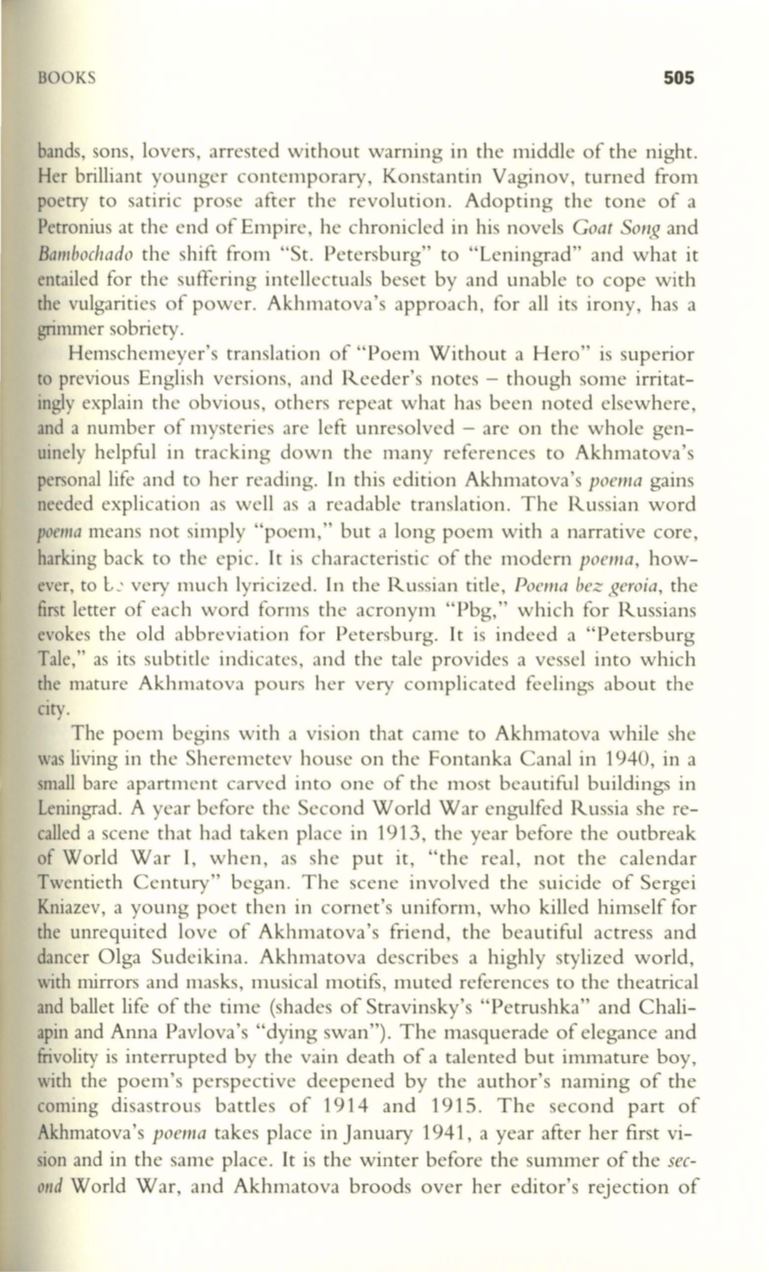
BOOKS
505
bands, sons, lovers, arrested without warning in the middle of the night.
Her brilliant younger contemporary, Konstantin Vaginov, turned from
poetry to satiric prose after the revolution. Adopting the tone of a
Petroruus at the end of Empire, he chronicled in his novels
Coat Song
and
Balllbochado
the shift from "St. Petersburg" to "Leningrad" and what it
entailed for the suffering intellectuals beset by and unable to cope with
the vulgarities of power. Akhmatova's approach, for all its irony, has a
grimmer sobriety.
Hemschemeyer's translation of "Poem Without a Hero" is superior
to previous English versions, and Reeder's notes - though some irritat–
ingly explain the obvious, others repeat what has been noted elsewhere,
and a number of mysteries are left unresolved - are on the whole gen–
uinely helpful in tracking down the many references to Akhmatova's
personal life and to her reading. In this edition Akhmatova's
poema
gains
needed explication as well as a readable translation. The Russian word
poellla
means not simply "poem," but a long poem with a narrative core,
harking back to the epic. It is characteristic of the modern
poema,
how–
ever, to
L'
very much lyricized. In the Russian title,
Poel1la bez geroia,
the
first letter of each word forms the acronym "Pbg," which for Russians
evokes the old abbreviation for Petersburg. It is indeed a "Petersburg
Tale," as its subtitle indicates, and the tale provides a vessel into which
the mature Akhmatova pours her very complicated feelings about the
city.
The poem begins with a vision that came to Akhmatova while she
was living in the Sheremetev house on the Fontanka Canal in 1940, in a
small bare apartment carved into one of the most beautiful buildings in
Leningrad. A year before the Second World War engulfed Russia she re–
called a scene that had taken place in 1913, the year before the outbreak
of World War
I,
when, as she put it, "the real, not the calendar
Twentieth Century" began. The scene involved the suicide of Sergei
Kniazev, a young poet then in cornet's uniform, who killed himself for
the unrequited love of Akhmatova's friend, the beautiful actress and
dancer Olga Sudeikina. Akhmatova describes a highly stylized world,
with mirrors and masks, musical motifs, muted references to the theatrical
and ballet life of the time (shades of Stravinsky's "Petrushka" and Chali–
apin and Anna Pavlova's "dying swan"). The masquerade of elegance and
frivolity is interrupted by the vain death of a talented but immature boy,
with the poem's perspective deepened by the author's naming of the
coming disastrous battles of 1914 and 1915. The second part of
Akhmatova's
poema
takes place in January 1941, a year after her first vi–
sion and in the same place. It is the winter before the summer of the
sec–
olld
World War, and Akhmatova broods over her editor's rejection of


